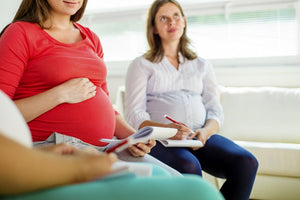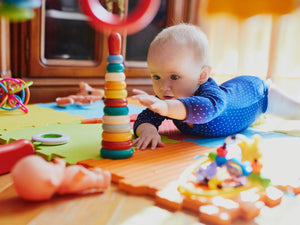Key Points
- Contrary to past beliefs, vaginal birth after caesarean (VBAC) has become a feasible childbirth option for many women who've had previous caesarean sections
- With proper support and monitoring, around 72-76% of women achieve successful VBAC
- Wait at least 12 months after the last caesarean section, maintain overall health, and plan to deliver in a hospital with close monitoring
- Discuss options with a maternity care provider, consider an epidural, and be realistic about individual chances of success
What are my options?
We used to believe that once a woman had one baby by caesarean section birth, she would automatically need to have caesareans for all future babies. But for the last few years this theory has been turned on its head.
Vaginal birth after caesarean, or VBAC as it’s more commonly known, has, in many cases, become a childbirth option for women who’ve previously had a lower segment caesarean section.
The general advice is for women who are planning to have more than two children to consider a VBAC. This is because of the associated risks with repeated caesarean sections.
Just Give Me the VBAC Statistics
- With the right support and monitoring, around 72-76% of women have a successful VBAC.
- If a woman has had a vaginal birth in the past, then the rate of success increases to 89%.
- If the previous caesarean birth was because the baby was breech, the chances of success are 86%.
- If the previous caesarean section was because of placenta praevia (a low lying placenta which completely or partially covers the cervix), the odds of success are 86%.
What Are the Benefits of Having a VBAC?
- A quicker recovery time.
- Less blood loss.
- A shorter hospital stay.
- For some women, a sense of achievement that they’ve had a vaginal birth.
- The possibility of having another vaginal birth if the VBAC went well.
- Less risk of infection and surgical complications.
- Less chance of complications and risks connected with other major abdominal surgery.
- Less risk for the baby, including being born when they are ready.
- Higher chances of early, successful breastfeeding.
- Some people believe that a vaginal birth makes it easier to bond with the baby.
What Are the Risks of Having a VBAC?
The major risk for the mother is a uterine rupture. When the uterus is scarred from a previous caesarian this creates an area which isn’t as strong as if it were intact.
The type of incision (cut) done at the previous caesarean is important. A vertical cut is more risky for uterine rupture during VBAC than a horizontal – side to side – incision. If a woman has had a previous lower uterine section caesarean section then the risks of uterine rupture is less than 1%. This is because the lower segment of the uterus does not contract.
Around 1:200 VBACs results in a uterine rupture. This can be life threatening to both the mother and her baby. A rupture of the uterus can also lead to hysterectomy and other complications.
There are a few circumstances which help the success of a woman having a VBAC. If she has had a previous successful vaginal birth or VBAC, if she goes into labour spontaneously and if her pregnancy has been uncomplicated and without any other risk factors.
What is a Trial of Labour?
This is generally a recommendation for women aiming for a VBAC. Maternity care providers are careful about providing evidence based information on success rates, and caution women not to automatically assume they’ll have a VBAC.
A Trial of Labour Involves
- Early assessment in labour.
- Continuous CTG) cardiotocograph monitoring.
- An intravenous drip being inserted.
- Clear fluids only in case a caesarean section is needed.
- Careful assessment of the labour and how it is progressing. This includes regular vaginal examinations for evidence of the labour progressing.
What Are the Symptoms of a Ruptured Uterus?
- Severe pain which doesn’t go away even between contractions.
- Shoulder tip and/or chest pain.
- Feeling short of breath, heart racing and perhaps, feelings of fear and generalised anxiety.
- Acute, intense pain in the area of the old scar.
- Changes in the CTG (cardiotocograph) which shows the baby is becoming stressed.
- Vaginal bleeding or blood in the urine.
- Changes in the mother’s blood pressure and heart rate.
What Can I do to Increase my Chances of Having a VBAC?
- Wait at least 12 months (ideally 18-24 months) to conceive again after your last caesarean section birth.
- Stay well and healthy. General medical or pregnancy complications increase the risk of needing another caesarean.
- Plan to have your baby in a hospital where you and your baby will be closely monitored.
- Don’t gain too much pregnancy weight. Women with a higher than normal BMI i.e. greater than 30, are not suitable candidates for a VBAC.
- Aim to have your baby before 41 weeks gestation. Babies greater than 4 kgs decrease the chances of a VBAC going as well as if they are less than 4kgs.
- Go into labour naturally. Inducing labour reduces the success rate of VBAC and increases the risk of uterine rupture. Speak with your maternity care provider about options which are right for you.
- Have a little chat with your baby about being in the optimal position. This means head down with their back against your front. Who knows if they can’t hear you?
- Be open to having an epidural. Evidence has shown that VBAC success rates are higher for women who have an epidural compared with those who don’t.
- Ask for a debrief with your maternity care provider after the initial caesarean section. It is important to fully understand why the caesarean birth was necessary and the possibility of having a VBAC in the future.
- Be realistic about your own individual chances of having a successful VBAC. Studies have shown that the women who have had three previous caesarean births, have a history of birth dystocia (difficult) birth, are older, or have a BMI > 30 are less likely to go on to have a subsequent VBAC.
- Check here for a (US based) calculator based prediction tool which will give you an informed idea of your chances of having a successful VBAC.
If You are Keen for a VBAC
- Read the Royal Australian and New Zealand College of Obstetricians and Gynaecologists (RANZCOG) information sheet on VBAC.
- Speak with your maternity care provider who knows you and your individual history.
- Start doing your research early.
- Join a VBAC support group and hear the stories of women who have or are experiencing the same situation as you are.
- Remember that you need to be as fully informed as possible.
Just Remember
It’s important to be open to changes of plan about how your baby will be born. Although VABC is the ultimate aim, there are never any guarantees about the outcome of labour and childbirth.
Having a VBAC is about weighing up the balance of risks versus benefits. Your own and your baby’s health and wellbeing are the most important factors to consider.
About the Author:
Jane Barry has qualifications in general, paediatric, immunisation, midwifery and child health nursing. She holds a Bachelor Degree in Applied Science (Nursing) and has almost 30 years specialist experience in child health nursing. She is a member of a number of professionally affiliated organisations including AHPRA, The Australasian Medical Writer’s Association, Health Writer Hub and Australian College of Children and Young People’s Nurses.
References
American College of Obstetricians and Gynaecologists
Maternal Fetal Medicine Networks
Government of Western Australia Department of Health
eatforhealth.gov.au
Better Health Channel
The Royal Australian and New Zealand College of Obstetricians and Gynaecologists
Our Products
-

01. Guide to a Healthy Pregnancy
$55 -

02. Positive Birthing Course
$55 -

03. Infant Feeding Guide
$55 -

04. Baby Sleep Guide - First 12 Months
$55 -

05. Toddler Parenting Course 1 - 3 Years
$55
-
 When to Start Antenatal Classes?
When to Start Antenatal Classes?
Becoming a parent is an incredible milestone, but it comes with a host of changes that can be daunting, especially for first time parents. Antenatal classes are all about offering expectant parents the education they need to make informed decisions, look after their bodies and care for their newborn babies. While you probably already have a long list of things you need to accomplish during your pregnancy, it’s a good idea to make time to attend antenatal classes.
-
 Development Milestones 4-8 Months
Development Milestones 4-8 Months
As they reach the middle of their first year, you'll start to see bigger leaps in their growth and ability!
In this article, we’re going to discuss your baby’s developmental milestones between 4-8 months, and what you can expect along the way.





 When to Start Antenatal Classes?
When to Start Antenatal Classes?
 Development Milestones 4-8 Months
Development Milestones 4-8 Months








